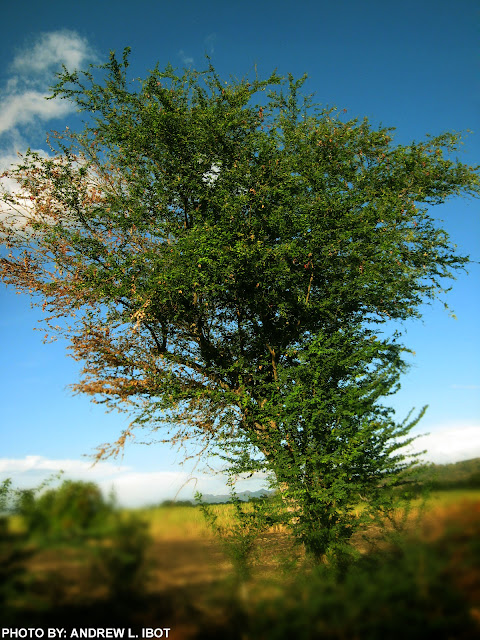Other scientific names
Inga camatchili
Inga dulcis
Inga lanceolata
Mimosa dulcis
Mimosa unguis
Acacia dulcis Roxb.
Common names
Camachile (Pamp)
Chamultis (Ig.)
Damortis (Ilk.)
Damulkis (Bon.)
Kamachili (Tag., Bik)
Kamachilis (Tag.)
Kamanchilis (P. Bis., Mag.)
Kamansile (Tag.)
Kamantilis (Pang.)
Kamarsiles (Tag.)
Kamatsele (Tag.)
Kamonsiles (Tag.)
Kamunsil (P. Bis.)
Karamansili (Ibn.)
Komonsili (P. Bis.)
Komontos (Ting.)
Komontres (Ting.)
Madras thorn (Engl.)
Sweet tamarind (Engl.)
Inga camatchili
Inga dulcis
Inga lanceolata
Mimosa dulcis
Mimosa unguis
Acacia dulcis Roxb.
Common names
Camachile (Pamp)
Chamultis (Ig.)
Damortis (Ilk.)
Damulkis (Bon.)
Kamachili (Tag., Bik)
Kamachilis (Tag.)
Kamanchilis (P. Bis., Mag.)
Kamansile (Tag.)
Kamantilis (Pang.)
Kamarsiles (Tag.)
Kamatsele (Tag.)
Kamonsiles (Tag.)
Kamunsil (P. Bis.)
Karamansili (Ibn.)
Komonsili (P. Bis.)
Komontos (Ting.)
Komontres (Ting.)
Madras thorn (Engl.)
Sweet tamarind (Engl.)
Tree 5-18 meters high, with pendulous branches, with short, sharp stipular spines. The leaves are evenly 2-pinnate, 4 to 8 cm long. The flowers are white, in dense heads, 1 cm in diameter. Pods are turgid, twisted, and spiral, 10 to 18 cm long, 1 cm wide, and dehiscent along the lower suture. Seeds are 6-8, with an edible, whitish, pulpy aril. The arillus is sweet when the fruit is ripe.
Medicinal uses:
Frequent bowel movements: Decoction of bark taken as tea. The leaves, when applied as plasters, used for pain, venereal sores. Salted decoction of leaves, for indigestion; also used as abortifacient.
Gen info / Etymology
Referred to as manila tamarind because of the sweet-sour tamarind-like taste. Genus Pithecellobium derives from from the Greek words 'pithekos' (ape) and 'lobos' (pod), and the species name 'dulce' from the Latin 'dulcis' meaning sweet.
Botany
Tree 5-18 meters high, with pendulous branches, with short, sharp stipular spines. The leaves are evenly 2-pinnate, 4 to 8 cm long. The flowers are white, in dense heads, 1 cm in diameter. Pods are turgid, twisted, and spiral, 10 to 18 cm long, 1 cm wide, and dehiscent along the lower suture. Seeds are 6-8, with an edible, whitish, pulpy aril. The arillus is sweet when the fruit is ripe.
Distribution
Found throughout the Philippines at low or medium altitudes.
Constituents
Tannin, 25.36%; fixed oil, 18.22%, olein.
A glycoside quercitin has been isolated.
Seeds have been reported to contain steroids, saponins, lipids, phospholipids, glycosides, glycolipids and polysaccharides.
Roots reported to be estrogenic.
Properties
Considered abortifacient, anodyne, astringent, larvicidal, antibacterial, antiinflammatory, febrifuge, antidiabetic.
Parts used and preparation
Bark, leaves.
Uses
Nutrion
Pulp around the seed is edible.
Folkloric
- Frequent bowel movements: Decoction of bark taken as tea.
- The leaves, when applied as plasters, used for pain, venereal sores.
- Salted decoction of leaves, for indigestion; also used as abortifacient.
- Bark used in dysentery, dermatitis and eye inflammation.
- In Brazil, P. avaremotem, used as a cancer elixir.
- In Mexico, decoction of leaves for earaches, leprosy, toothaches and larvicide.
- In India, bark of the plant used as astringent in dysentery, febrifuge. Also used for dermatitis and eye inflammations. Leaves used as abortifacient.
- In Guiana, root bark used for dysentery and as febrifuge.
Studies
- Anti-Inflammatory / Antibacterial: Study of the fresh flowers of Pithecellobium dulce yielded a glycoside quercitin. The activity of the flavonol glycoside confirmed its antiinflammatory and antibacterial properties.
- Phenolics / Antioxidant: Free Radical Scavenging Activity of Folklore: Pithecellobium dulce Benth. Leaves: Study of the aqueous extract of Pithecellobium dulce leaves revealed phenolics including flavonoids and showed potent free radical scavenging activity..
- Anti-inflammatory Triterpene: Anti-inflammatory triterpene saponins of Pithecellobium dulce: characterization of an echinocystic acid bisdesmoside. A new bisdesmodic triterpenoid saponin, dulcin, was isolated from the seeds of PD
- Genotoxicity: Mutagenic and Antimutagenic Activities in Philippine Medicinal and Food Plants: In a study of 138 medicinal plants for genotoxicity, Pithecellobium dulce was one of 12 that exhibited detectable genotoxicity in any system.
- Anti-tuberculosis / Antimicrobial: Hexane, chloroform and alcoholic leaf extracts were studied for activity against Mycobacterium tuberculosis strains. The alcoholic extract showed good inhibitory activity and antimicrobial activity against secondary pathogens.
- Anti-Diabetic: Study of ethanolic and aqueous leaf extract of P dulce in STZ-induced diabetic model in rats showed sigificant activity, aqueous more than the alcoholic extract, comparable to glibenclamide.
- Anti-Ulcer / Free Radical Scavenging: Study of the hydroalcoholic extract of PD was found to possess good antioxidant activity and suggests possible antiulcer activity with its free-radical scavenging and inhibition of H, K-ATPase activities comparable to omeprazole. Phytochemical screening yielded flavonoids - quercetin, rutin, kaempferol, naringin, daidzein.
Wild crafted.












No comments:
Post a Comment